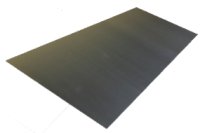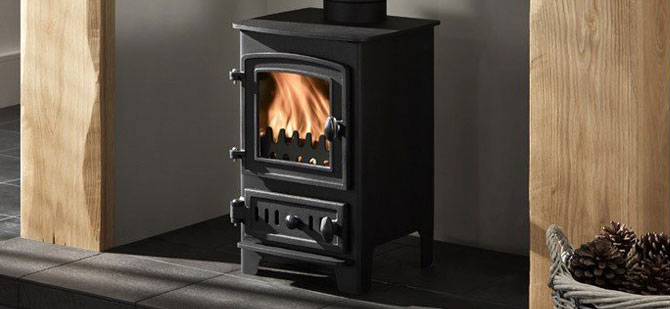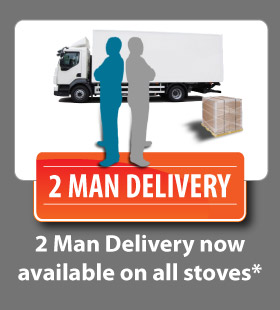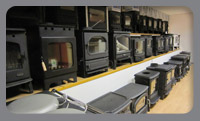Twinwall Flue System

Twin wall insulated flue is suitable for constructing internal and external flue systems for wood burning stoves, multi-fuel stoves, gas and high temperature oil stoves. Our twinwall flue pipe is a double skinned flue that is approved by the latest Hetas official guide for approved solid fuel products. Our twin wall insulated flue pipe is made with an inner layer of 316 grade stainless steel a 25mm insulation section of rockwool and a outer layer of 304 grade steel.
The outer layer of the insulated flue may pass within 50mm of combustible materials. This enables relatively easy installation in existing houses, where internal, or external space may be a problem. Twinwall insulated flue is weatherproof and carries the structural load of the flue system.
Rockwool is a high-density mineral, which has extremely good thermal resistant properties. It is packed between the layers of the twinwall, keeping the internal workings of the flue system hot, ensuring the waste gases stay warm and rise up the flue efficiently, reducing the build-up of tar, which is the primary cause of chimney fires. The external layer of twinwal remains cool, allowing it to pass with 50mm of combustible materials, as outlined above.
The inner layer is made of 316 grade stainless steel and is able to withstand the corrosive flue gases excreted by wood and coal burning stoves. The inner steel heats up rapidly to produce a strong draught and this ensures that waste gases are exhausted swiftly up the flue. The steel can also contract and expand as gas temperatures change throughout the burning of the stove.
Twinwall flue systems should be installed with the minimum amount of horizontal turns and offsets. For solid fuel appliances the distance between two 45 degree bends should not surpass 20% of the vertical flue height. The flue size of the twin wall system should never be reduced to less than the flue diameter on the stove, often stove manufactures recommend an increase in the flue diameter.
All lengths and offsets connect together using a locking band system which seals the flue and prevents any leakage, no joints should be made in walls or going through floors. Access must be made for sweeping and inspection purposes these are generally found in Vitreous enamel pipes with sweeping hatches or in 135 degree twinwall insulated Tee & Cap's.
For the Flue system to work correctly you must ensure that adequate air is available for combustion, for full details refer to Document J Building Regulations.
All Flue systems must have enough support. There are a range of adjustable and fixed support brackets available, we recommend a support bracket every 2m.
To go from Vitreous Enamel Flue Pipe to Twinwall Insulated Flue Pipe a special adapter is required. This adapter seals the joint and also allows you to increase the diameter of the flue. We recommend you increase the flue diameter in all flue systems, helping to increase draw.
When a double skinned twin wall flue system needs to travel 45 degree diagonally through a vertical wall an adjustable twin-wall length is often required. This twin wall length is usually adjustable as it is difficult to measure wall thickness. The Twin-wall adjustable lengths come in two different sizes the smaller of the two is 250mm - 450mm and the larger is 500mm - 950mm. Whilst going through a wall the gap between the adjustable twinwall flue pipe and the wall itself is generally packed out with vermiculite to prevent any condensation but always consult your Hetas qualified fitter for any installation details and up-to-date regulations.

Clearance heights of the relevant flue outlets are as follows:
A = Must terminate at least 600mm above the ridge.
B = Must terminate at least 2300mm from the nearest point of the weather surface (at least the height of the ridge, or 1000mm above the highest point of the inter-section).
C = At least 1000mm above the top of the opening.
D = At least 600mm above the ajacent building.
Please note:
1. The weather surface is the the buildings external surface, such as roof tiles.
2. A flat roof has a pitch of less than 10 degree.
3. The clearances given in A & B apply to a flat roof.
We offer a FREE Twinwall design service, simply email or fax a drawing of your requirements to us at [email protected] . Our twinwall experts will select all the relevant components required and will get back to you with a product breakdown and no obligation quote.
Please contact our technical team using any of the following methods, with your diagram, name and contact numbers all clearly marked. When emailing or faxing a diagram please ensure you include the following dimensions:
Overall height, flue outlet size on the stove, wall thickness (if applicable), height to each ceiling, loft space and roof angle.

The register plate is often overlooked when buying a stove. Register plates are essential when installing a stove, as they prevent any debris caused by the stove, or flue, falling back down onto your hearth and they ensure your chimney is fume-tight.
Our galvanised steel register plates are 1.5mm thick with a circular cut-out to accomodate the stove pipe. Seal the stove pipe and register plate with fire cement and ceramic fire rope. It is also beneficial to have a lip on the register plate, allowing you to drill and secure the plate to the inside of your chimney breast. Please consult a Hetas qualified fitter for installation advice.
















